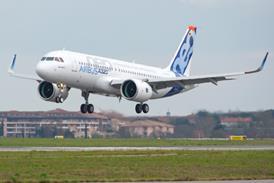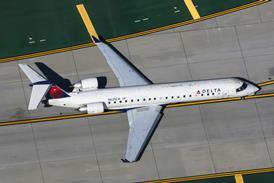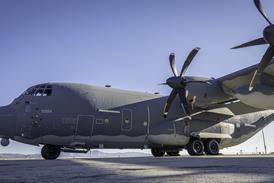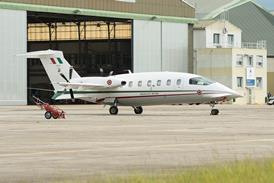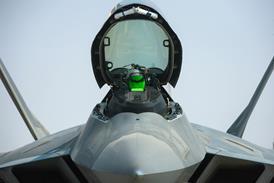The four bolts intended to secure the door plug that failed on an Alaska Airlines Boeing 737 Max 9 in January were missing at the time plug blew out, causing a rapid de-pressurisation.
That is according to a preliminary report released on 6 February by the National Transportation Safety Board (NTSB), which says damage to the jet’s left-side mid-cabin emergency exit door plug, and to the aircraft’s fuselage, indicate the bolts were not in place.
The NTSB also obtained a photograph, taken at Boeing’s Renton facility before the jet was delivered, showing the door plug closed without the bolts.
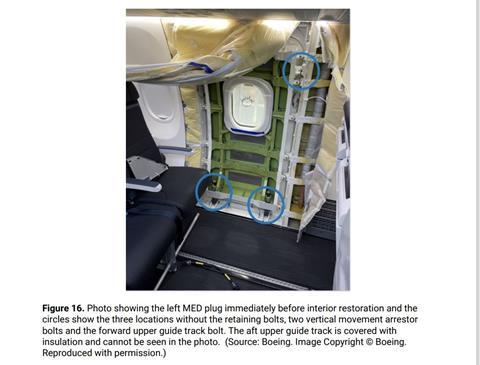
“The four bolts that prevent upward movement of the… plug were missing before the… plug moved upward off the stop pads,” says the NTSB’s report.
The incident involved Alaska flight 1282, which took off from Portland on 5 January, headed to Ontario, California. During ascent, at about 16,000ft, the plug blew out, causing rapid de-pressurisation and leaving a hole in the side of the jet. The pilots returned to Portland and landed safely. Seven passengers and one flight attendant suffered minor injuries, the NTSB says.
Spirit manufactured the door plug at a facility in Malaysia in March 2023. It received the plug at its Wichita site in May last year, installed the plug in a 737 Max 9 fuselage and shipped that fuselage to Boeing in August.
The plugs are made from aluminium and secure to the Max 9’s fuselage with two upper-guide fittings and two lower-hinge fittings. Four bolts secure the plugs to the fuselage – one bolt through each upper-guide fitting and one through each lower-hinge fitting.

The Alaska Max 9 fuselage arrived at Boeing’s Renton site on 31 August. On 1 September, someone at Boeing created a “non-conformance record” report saying that five damaged rivets had been found on the jet’s frame, forward of the door plug.
Fixing the rivets required removing the door plug, which necessitated removing the four bolts, the NTSB says. Spirit personnel at Boeing’s site finished replacing the damaged rivets on 19 September.
“Photo documentation obtained from Boeing shows evidence of the left-hand… plug closed with no retention hardware (bolts) in the three visible locations,” says the NTSB, noting that one location is covered with insulation and therefore concealed from view.
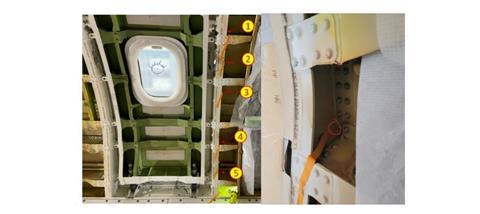
“The investigation continues to determine what manufacturing documents were used to authorise the opening and closing of the left… plug during the rivet rework,” the NTSB says.
“Boeing appreciates the US National Transportation Safety Board’s work and will review their findings expeditiously. And we will continue to cooperate fully and transparently with the NTSB and the FAA investigations,” the company says.
The report provides other details about the incident, including the accounts of flight crew.
“The captain said that while climbing through about 16,000ft there was a loud bang. The flight crew said their ears popped, and the captain said his head was pushed into the heads-up display and his headset was pushed up, nearly falling off his head,” the report says. “The [first officer] said her headset was completely removed due to the rapid outflow of air from the flight deck.”
Additionally, the cockpit door blew open from the de-pressurisation.
Both pilots donned oxygen masks and the first officer began completing the jet’s “rapid decompression checklist” while the captain flew the aircraft.
The NTSB says the jet’s cockpit voice recorder did not capture data during the incident because the unit had not been manually deactivated after the aircraft landed. The recorder, as required by regulations, only captured the previous 2h of audio, after which the data was over-ridden.
The agency notes that airlines, including Alaska, use plugs to deactivate mid-cabin doors on jets if those jets have few enough seats to not require extra exits. Plugging the exits saves about 87lb (39kg) of weight.


